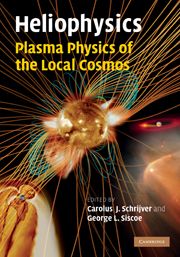Book contents
- Frontmatter
- Contents
- Preface
- 1 Prologue
- 2 Introduction to heliophysics
- 3 Creation and destruction of magnetic field
- 4 Magnetic field topology
- 5 Magnetic reconnection
- 6 Structures of the magnetic field
- 7 Turbulence in space plasmas
- 8 The solar atmosphere
- 9 Stellar winds and magnetic fields
- 10 Fundamentals of planetary magnetospheres
- 11 Solar-wind– magnetosphere coupling: an MHD perspective
- 12 On the ionosphere and chromosphere
- 13 Comparative planetary environments
- Appendix I Authors and editors
- List of illustrations
- List of tables
- References
- Index
12 - On the ionosphere and chromosphere
Published online by Cambridge University Press: 05 August 2013
- Frontmatter
- Contents
- Preface
- 1 Prologue
- 2 Introduction to heliophysics
- 3 Creation and destruction of magnetic field
- 4 Magnetic field topology
- 5 Magnetic reconnection
- 6 Structures of the magnetic field
- 7 Turbulence in space plasmas
- 8 The solar atmosphere
- 9 Stellar winds and magnetic fields
- 10 Fundamentals of planetary magnetospheres
- 11 Solar-wind– magnetosphere coupling: an MHD perspective
- 12 On the ionosphere and chromosphere
- 13 Comparative planetary environments
- Appendix I Authors and editors
- List of illustrations
- List of tables
- References
- Index
Summary
Introduction
In this chapter we review some basic physical processes in the upper atmospheres of planets, with a particular focus on Earth with its strong internal magnetic field. Less attention will be given to the upper atmospheres of planets with little or no internal magnetic field. The same basic physical processes operate in all planetary atmospheres. The main distinctions are in the species present (see the review by Bougher et al., 2002), the rotation rate and gravitational force, and whether the planet has a significant intrinsic magnetic field. The vertical extent, absorption of radiation, interaction with the solar wind, and dynamical balances will clearly differ. Planets with a small magnetic field will also have quite different electrodynamic properties.
Earth's upper atmosphere can be categorized as a gravitationally bound, partially ionized, fluid. The fluid properties of the gas result from the frequent collisions between the atoms and molecules of the medium. Rather than having to accommodate the random nature of the forces exerted on individual gas particles the principles of kinetic theory can be invoked, so that the medium can be described by the bulk properties of the fluid such as pressure, density, temperature, and velocity. The vertical extent of the sensible atmosphere is usually defined by the altitude at which the fluid approximation is no longer valid, referred to as the exobase. Below the exobase, i.e. the topmost extent of an atmosphere, the distance and time between collisions is short compared with the scale sizes of interest in the dynamics and energetics of the fluid.
- Type
- Chapter
- Information
- Heliophysics: Plasma Physics of the Local Cosmos , pp. 324 - 359Publisher: Cambridge University PressPrint publication year: 2009
- 2
- Cited by



